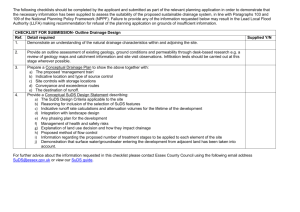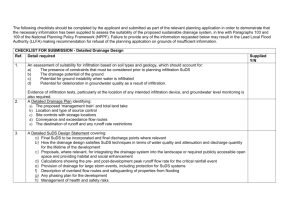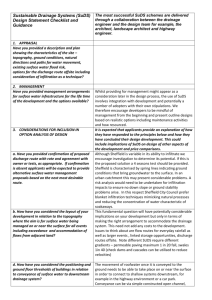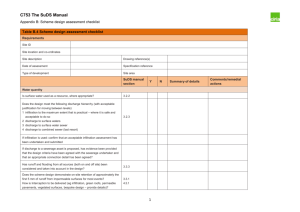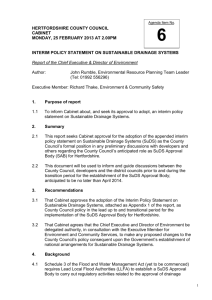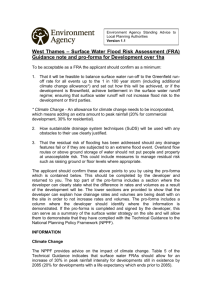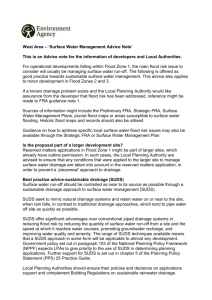Guidance on Construction Method Statements
advertisement
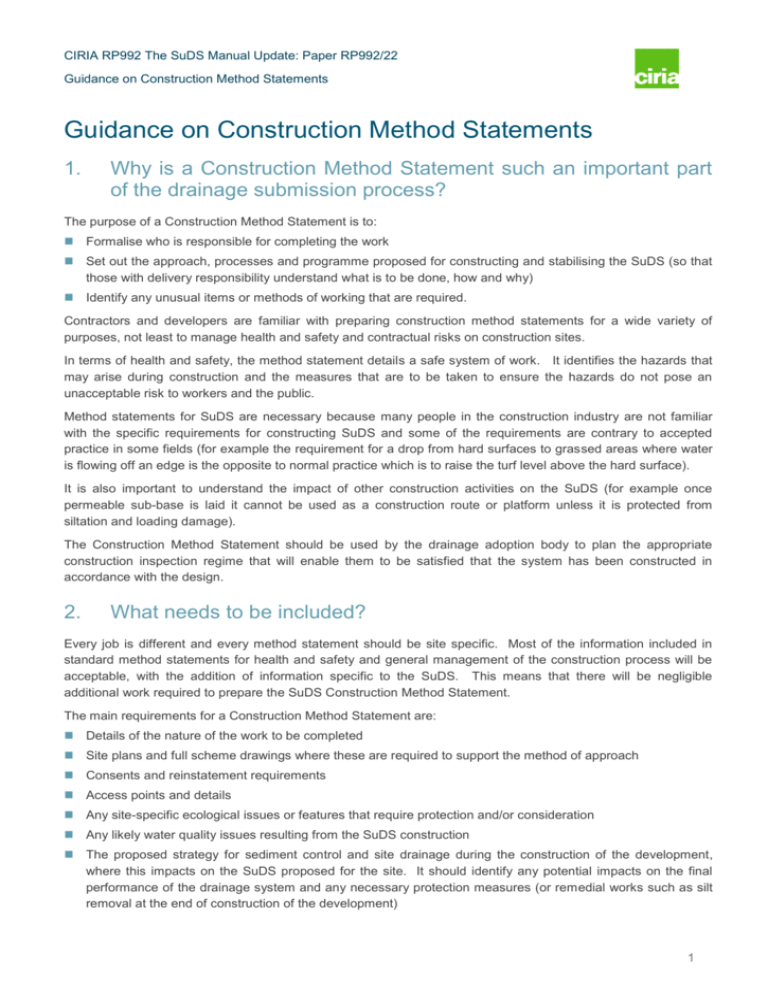
CIRIA RP992 The SuDS Manual Update: Paper RP992/22 Guidance on Construction Method Statements Guidance on Construction Method Statements 1. Why is a Construction Method Statement such an important part of the drainage submission process? The purpose of a Construction Method Statement is to: Formalise who is responsible for completing the work Set out the approach, processes and programme proposed for constructing and stabilising the SuDS (so that those with delivery responsibility understand what is to be done, how and why) Identify any unusual items or methods of working that are required. Contractors and developers are familiar with preparing construction method statements for a wide variety of purposes, not least to manage health and safety and contractual risks on construction sites. In terms of health and safety, the method statement details a safe system of work. It identifies the hazards that may arise during construction and the measures that are to be taken to ensure the hazards do not pose an unacceptable risk to workers and the public. Method statements for SuDS are necessary because many people in the construction industry are not familiar with the specific requirements for constructing SuDS and some of the requirements are contrary to accepted practice in some fields (for example the requirement for a drop from hard surfaces to grassed areas where water is flowing off an edge is the opposite to normal practice which is to raise the turf level above the hard surface). It is also important to understand the impact of other construction activities on the SuDS (for example once permeable sub-base is laid it cannot be used as a construction route or platform unless it is protected from siltation and loading damage). The Construction Method Statement should be used by the drainage adoption body to plan the appropriate construction inspection regime that will enable them to be satisfied that the system has been constructed in accordance with the design. 2. What needs to be included? Every job is different and every method statement should be site specific. Most of the information included in standard method statements for health and safety and general management of the construction process will be acceptable, with the addition of information specific to the SuDS. This means that there will be negligible additional work required to prepare the SuDS Construction Method Statement. The main requirements for a Construction Method Statement are: Details of the nature of the work to be completed Site plans and full scheme drawings where these are required to support the method of approach Consents and reinstatement requirements Access points and details Any site-specific ecological issues or features that require protection and/or consideration Any likely water quality issues resulting from the SuDS construction The proposed strategy for sediment control and site drainage during the construction of the development, where this impacts on the SuDS proposed for the site. It should identify any potential impacts on the final performance of the drainage system and any necessary protection measures (or remedial works such as silt removal at the end of construction of the development) 1 CIRIA RP992 The SuDS Manual Update: Paper RP992/22 Guidance on Construction Method Statements A detailed programme for construction of the drainage works (including stabilisation and planting of exposed surfaces). The programme should highlight key points at which inspection is recommended Specific details where the proposed construction processes are unusual, unique or required by a specific product manufacturer What plant is required and how it will be used Simple illustrations, where necessary, to aid understanding of what is required. Full contact information for: Site Manager The name of the person on site (usually a foreman) who will be responsible for the work Other relevant professional contacts e.g. archaeologist, ecologist, SAB, EA Emergency contact details The contractor or developer should provide the method statement to the drainage approving body SAB prior to starting the drainage construction (and usually at drainage approval submission stage) and the statement should be discussed at a pre-contract meeting. The information in the method statement should be communicated to site staff via a tool box talk – which would routinely be required as part of the health and safety requirements for a site. There may be a general high level method statement that deals with, for example, phasing of different parts of the SuDS. Several more detailed statements that relate to specific work items may also be provided. Generic method statements should be avoided; they should be written for the site in question. 3 Where to find more information? Detailed information on the requirements for SuDS construction is provided in the Site handbook for the construction of SuDS (CIRIA C698, 2007). In addition, there are numerous method statements on the internet and the best approach is to read a few of those to gain an idea of what information is provided, then apply that knowledge to the SuDS method statement for the particular site. 2 CIRIA RP992 The SuDS Manual Update: Paper RP992/22 Guidance on Construction Method Statements Construction Assessment Checklist 4. Objectives The objective of a construction assessment is to verify that the drainage system is constructed in accordance with the approved design and specification. Verification can be undertaken by the drainage approving body, by independent consultants employed by the drainage approving body or developer (if employed by the developer the prior agreement of the SAB will be required), or a combination of these. If the verification visits and report are undertaken by a consultant employed by the developer there should be a contractual link to the drainage approving body via a warranty from the consultant in favour of the SAB, or some other mechanism. Conflicts of interest should be avoided in the verification process. A contractor, supplier (e.g. permeable pavements) or developer certifying their own work or product is considered to be a conflict of interest and is not good practice. Verification also requires a full understanding of the drainage system for the site, how it fits in with the overall flood risk strategy and the philosophy underpinning the design. A contractor employed to install drainage or a supplier of materials or components is not likely to have this level of understanding of the site. Selfcertification of construction is not acceptable. It is intended that the checklist gives a broad outline of the items that will require checking. The precise details will vary from scheme to scheme and the list should be adapted to suit each site. This will require the removal or addition of items as necessary. 5. Programme and Method of Approach Work should not start on site until the drainage approving body has formally approved the drainage design plans, method statement and specification in writing. Further to this approval being given, the drainage approving body should then be given at least two weeks’ notice of the proposed start of construction of the development and for larger sites should be provided with a programme of works. For smaller sites 48 hours’ notice of any works requiring inspection should be sufficient. The drainage approving body should be notified immediately, and with sufficient notice, of any significant changes to the program. This is to allow the drainage approving body sufficient opportunity to inspect the works. The Construction Method Statement should detail the specific SuDS construction methods and processes, and the construction programme, including key points at which inspection is recommended (e.g. when subsequent coverage of elements would mean inspection could not then be undertaken without removal of material). 6. Changes to design during construction It is inevitable that there will be changes to the design during construction. This is a normal part of construction. However, it is important that changes are not made without reference to the SAB and/or the designer. Major changes should be agreed with both the SAB and the designer prior to implementing them (major changes are things that can have a significant impact on the overall operation and maintenance of the SuDS, e.g. changing a pond to a basin). Minor changes should be agreed with the designer and the changes and agreement recorded for inclusion in the Verification Report (see below). 7. Verification report A verification report should be prepared at the end of construction by the party who has carried out the inspection visits. This should confirm if the drainage system has been constructed in accordance with the approved design. It should identify any changes that have been made to the design and the reasons for those changes, together with confirmation of any likely impact on the performance of the system (if an adverse impact is expected then 3 CIRIA RP992 The SuDS Manual Update: Paper RP992/22 Guidance on Construction Method Statements necessary remedial works should be specified). Evidence of the agreement of the SAB and/or designer to the changes should be included. The verification visit reports should indicate any defects in construction and follow up on any remedial works that are necessary to confirm they have been completed. The format of the report will be site specific but as a minimum it will be expected to include the following: Photographs of excavations, confirmation of soil conditions, confirmation of levels, profiles and general earthworks. Photographs and full manufacturer’s details (if appropriate) of inlets, outlets and any control structures associated with any feature to be adopted. Confirmation of topsoil sources with appropriate certificates. Full planting lists and confirmation of plant sources, planting method statement and initial maintenance regime. Confirmation of subsoil and topsoil depths. Confirmation of gravel fill/sub-base specification and sources, installation method statement of filter drains/permeable pavements. Confirmation of source and test certificates for membrane liners if used. Membranes shall have welded joints and shall be inspected and the joints tested after installation. Records of the tests shall be provided. Integrity tests may be necessary if the membrane performance is critical. Photographs of the feature before and after planting. Full ‘as-constructed’ drawings and a topographical survey of the ‘as-constructed’ system. Confirmation of initial maintenance regimes. 4 CIRIA RP992 The SuDS Manual Update: Paper RP992/22 Guidance on Construction Method Statements Table 1: Construction Assessment Checklist GENERAL INFORMATION Site ID Asset ID(s) (note the checklist can be used for a single component or a complete system) Site Location(s) and co-ordinates Drawing Reference(s) Contractor/Developer Specification Reference(s) INSPECTION DATES Items/parts of system inspected Check Details Y N Details Y N Details Y N GENERAL Appropriate erosion and sediment control strategy implemented (including protection of any infiltration or permeable surfaces, permeable sub-base and stabilisation following earthworks)? Location, layout and plan area as per approved drawings? Critical root zones of nominated trees protected? Any identified ecological features adequately protected? 5 CIRIA RP992 The SuDS Manual Update: Paper RP992/22 Guidance on Construction Method Statements Check Details Y N Details Y N Details Y N EARTHWORKS Levels and gradients as per approved drawings? Side slopes and benches as per approved drawings? Provision of subsoil drainage as per approved drawings? Topsoil depths as per approved drawings? Formation levels as per approved drawings Formation level soils as per design assumptions (e.g. CBR value)? Side slopes of temporary excavations for tanks as per approved drawings? Utilities access covers and street furniture details acceptable? (e.g. correct detailing of block paving around covers, not impeding flow in swales, etc.) HYDRAULIC PROPERTIES Water levels as per approved drawings? Flow controls as per approved design? STRUCTURAL COMPONENTS Check dams/weirs/overflows as per design? Service or other crossings as per design? Pipe connections as per design? Inlets – as per design, appropriate installation (including concrete & reinforcement works, erosion protection, level spreaders, buffer strips, kerbing and drops) 6 CIRIA RP992 The SuDS Manual Update: Paper RP992/22 Guidance on Construction Method Statements Check Details Y N Details Y N Details Y N Outlets – as per design, appropriate installation (including concrete & reinforcement works, erosion protection) Any required geotextile/geomembrane test certificates provided and in accordance with approved drawings and/or specification? MATERIALS Topsoil meets approved specification (tested and ameliorated if required, certificates verifying source and content)? Planting implemented as per approved drawings and landscape schedules? Geo-cellular storage units as per approved design drawings and specification? Permeable sub-base as per approved drawings and specification? Root zone materials, filter sand, etc. as per approved drawing and specification? Perforated pipes as per approved drawings and specification? FINAL INSPECTION Confirm inlet and outlet levels Confirm structural components Confirm slopes Confirm correct planting/turfing established Confirm no uneven settling of soil, channelling, unwanted ponding or erosion of bed or side slopes 7 CIRIA RP992 The SuDS Manual Update: Paper RP992/22 Guidance on Construction Method Statements Check Details Y N Details Y N Details Y N Confirm no evidence of construction sediment or unexpectedly rapid build-up of sediment Confirm that agreed access for maintenance is clear Additional information appended Photographs Test certificates Other (details) 8 CIRIA RP992 The SuDS Manual Update: Paper RP992/22 Guidance on Construction Method Statements
